Apache Kafka - How to Load Test with JMeter
In this article, we are going to look at how to load test Apache Kafka, a distributed streaming platform, by using Apache JMeter™. First of all, let us study what Kafka is and give a few definitions we will need for further work.
A Brief Overview of Apache Kafka
In a large distributed system, there are usually a lot of services that generate different events: logs, monitoring data, suspicious user actions, and so on. In Kafka, these are called producers. On the other hand, there are services that need the generated data. These are called consumers.
Kafka that solves the problem of interaction between these services. It sits between producers and consumers, while collecting the data from the producers, storing them in a distributed repository of topics and giving each consumer the data by subscription. Kafka is launched as a cluster consisting of one or several servers, each of which is called a broker.
In other words, Kafka is a hybrid of a distributed database and a message queue. It is widely known for its features and is used by many large companies to process terabytes of information. For example, in LinkedIn Apache Kafka is used to stream data about user activity, and Netflix uses it for data collection and buffering for downstream systems like Elasticsearch, Amazon EMR, Mantis etc.
Let’s look at some of Kafka’s features that are important for load testing:
- A long message storing time - a week, by default
- High performance, thanks to sequential I/O
- Convenient clustering
- High availability of data due to the capability to replicate and distribute queues across the cluster
- Not only is it able to transfer data, but it can also process it by using Streaming API
As a rule, Kafka is used to work with a very large amount of data. Therefore, the following aspects should be paid attention to during load testing:
- Constantly writing the data to the disk will affect the capacity of the server. If insufficient, it will reach a denial of service state.
- In addition, the distribution of sections and the number of brokers also affects the use of service capacity. For example, brokers may simply not have enough resources to process the data stream. As a result, the producers will exhaust local buffers for storing messages, and part of the messages may be lost.
- When the replication feature is used, everything becomes even more complicated. This is because its maintenance requires even more resources, and the case when brokers refuse to receive messages becomes even more possible.
Data that is processed in such huge amounts, can be very easily lost, even though most processes are automated. Therefore, testing of these services is important and it is necessary to be able to generate a proper load.
To demonstrate load testing Apache Kafka, it will be installed on Ubuntu. Besides, we will use the Pepper-Box plugin as a producer. It has a more convenient interface to work with message generation than kafkameter does. We will have to implement the consumer on our own, because no plugin provides consumer implementation, and we are going to use the JSR223 Sampler to do that.
Configuring The Producer - Pepper-Box
To install the plugin, you need to compile this source code or download the jar file, then put it in the lib/ext folder and restart JMeter.
This plugin has 3 elements:
- Pepper-Box PlainText Config allows building text messages according to a specified template.
- Pepper-Box Serialized Config allows building a message that is a serialized java object.
- PepperBoxKafkaSampler is designed to send the messages that were built by previous elements.
Let us look at each of them.
Pepper-Box PlainText Config
To add this item, go to the Thread group -> Add -> Config Element -> Pepper-Box PlainText Config

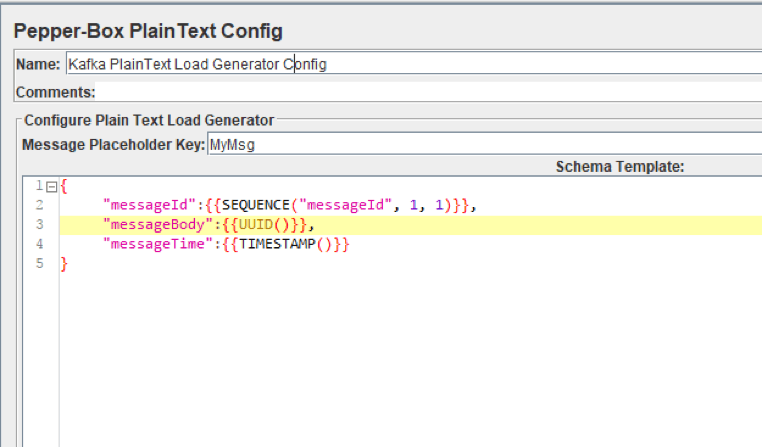
As you can see in the picture above, the element has 2 fields:
- Message Placeholder Key - a key that will need to be specified in the PepperBoxKafkaSampler to use the template from this element.
- Schema Template - a message template in which you can use JMeter variables and functions, and also plugin functions. The structure of the message can be anything, from plain text, to JSON or XML.
For example, in the screenshot above, we are passing the JSON string as a message, using several plugin functions: to specify the message number, to specify the identifier and the sending timestamp.
Pepper-Box Serialized Config
To add this element, go to Thread group -> Add -> Config Element -> Pepper-Box Serialized Config

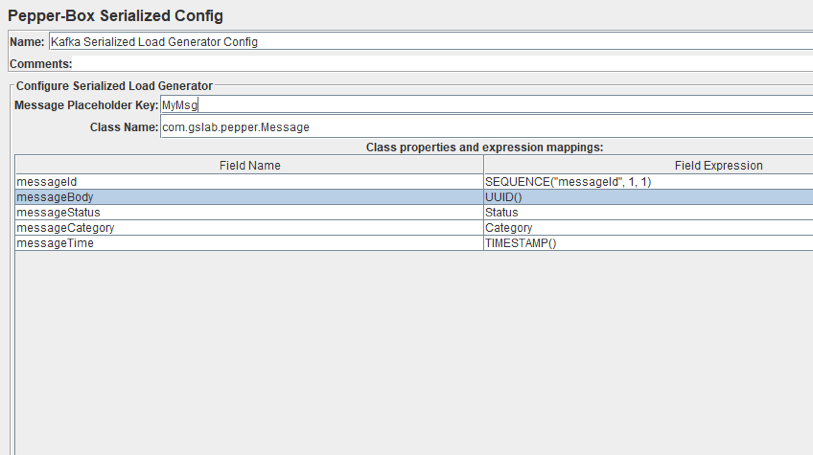
As you can see in the picture above, the element has a field for the key and the Class Name field, which is intended for specifying the Java class. The jar file with the class must be placed in the lib/ext folder. After it is specified, the fields with its properties will appear below, and you can assign desired values to them. We repeated the message from the last element, but it will be a Java object this time.
PepperBoxKafkaSampler
To add this element, go to Thread group -> Add -> Sampler -> Java Request. Then, select com.gslab.pepper.sampler.PepperBoxKafkaSampler from the drop-down list.

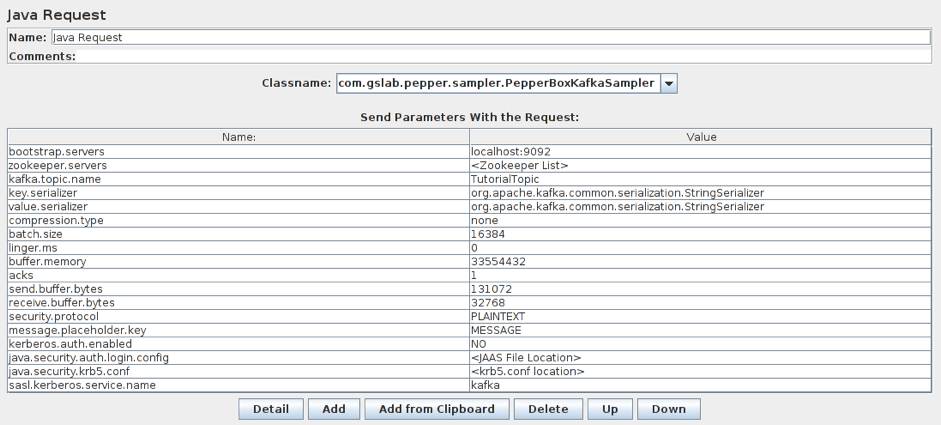
This element has the following settings:
- bootstrap.servers/zookeeper.servers - the addresses of brokers/zookeepers (a zookeeper is an interface that distributes the load from the producers between different brokers) in the format of broker-ip-1: port, broker-ip-2: port, etc.
- kafka.topic.name - is the name of the topic for message publication.
- key.serializer - is a class for key serialization. Leave it unchanged if there is no key in the message.
- value.serializer - is a class for message serialization. For a simple text, the field remains unchanged. When using Pepper-Box Serialized Config, you need to specify "com.gslab.pepper.input.serialized.ObjectSerializer".
- compression.type - is a type of message compression (none/gzip/snappy/lz4)
- batch.size - is the largest message size.
- linger.ms - is the message waiting time.
- buffer.memory - is the producer's buffer size.
- acks - is the quality of service (-1/0/1 - delivery is not guaranteed/the message will surely be delivered/the message will be delivered once).
- receive.buffer.bytes/send.buffer.bytes - the size of the TCP send/receive buffer. -1 - use the default OS value.
- security.protocol - is the encryption protocol (PLAINTEXT/SSL/SASL_PLAINTEXT/ SASL_SSL).
- message.placeholder.key - is the message key, which was specified in the previous elements.
- kerberos.auth.enabled, java.security.auth.login.config, java.security.krb5.conf, sasl.kerberos.service.name - are a field group responsible for the authentication.
Besides, if necessary, you can add additional parameters using the prefix _ before the name, for example, _ssl.key.password.
Configuring the Consumer
Now let us move on to the consumer. While it is the producer that creates the largest load on the server, the service has to deliver messages too. Therefore, we should also add consumers, to more accurately reproduce the situations. They can also be used to check whether all consumer messages have been delivered.
As an example, let us take the following source code and briefly touch upon its steps:
Properties props = new Properties();
props.put("bootstrap.servers", "localhost:9092");
props.put("group.id", group);
props.put("enable.auto.commit", "true");
props.put("auto.commit.interval.ms", "1000");
props.put("session.timeout.ms", "30000");
props.put("key.deserializer",
"org.apache.kafka.common.serializa-tion.StringDeserializer");
props.put("value.deserializer",
"org.apache.kafka.common.serializa-tion.StringDeserializer");
KafkaConsumer<String, String> consumer = new KafkaConsumer<String, String>(props); consumer.subscribe(Arrays.asList(topic));
System.out.println("Subscribed to topic " + topic);
int i = 0; while (true) {
ConsumerRecords<String, String> records = con-sumer.poll(100);
for (ConsumerRecord<String, String> record : records)
System.out.printf("offset = %d, key = %s, value = %s\n",
record.offset(), record.key(), record.value());
}
1. A connection configuration is performed.
2. A topic is to be specified and a subscription is made to it.
3. Messages are received in the cycle of this topic and are brought out to the console.
This code with some modifications will be added to the JSR223 Sampler in JMeter.
Building the Load Testing Apache Kafka Scenario in JMeter
Now that we have studied all the necessary elements for creating the load, let’s try posting several messages to the topic of our Kafka service. Let’s imagine that we have a resource from which the data on its activities are collected. The information will be sent as an XML document.
1. Add the Pepper-Box PlainText Config and create a template. The structure of the message will be as follows: Message number, Message-ID, Item ID which the statistics are collected from, the Statistics, Sending date stamp. The message template is shown in the screenshot below.

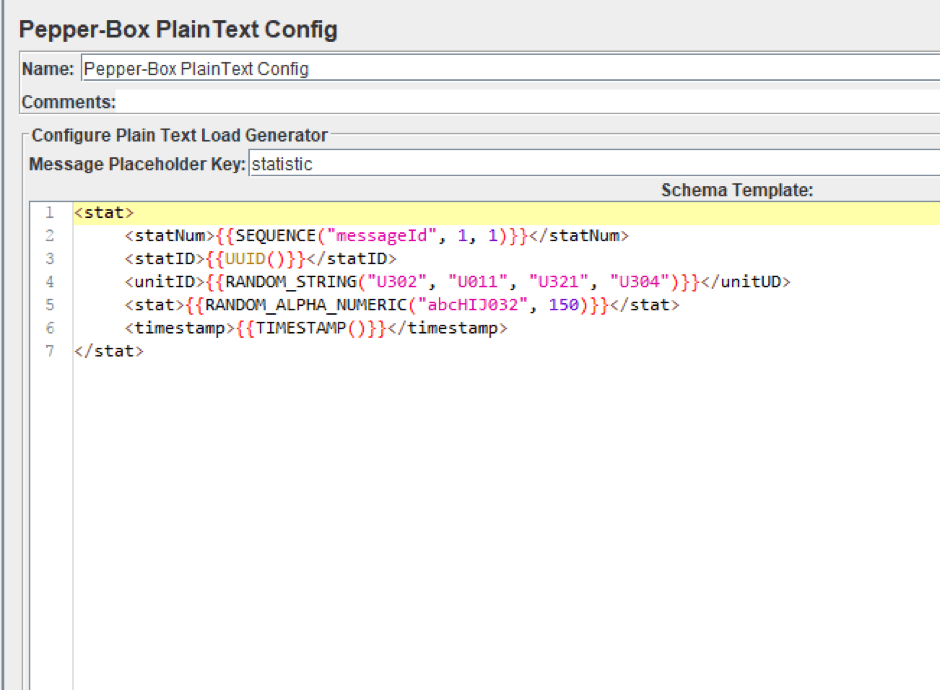
2. Add the PepperBoxKafkaSampler. In it, specify the addresses of bootstrap.servers and kafka.topic.name from our Kafka service. In our case, the address of broker is localhost:9092, topic for demonstration is TuttorialTopic. And we will also specify the placeholder.key from the template element from the previous step.

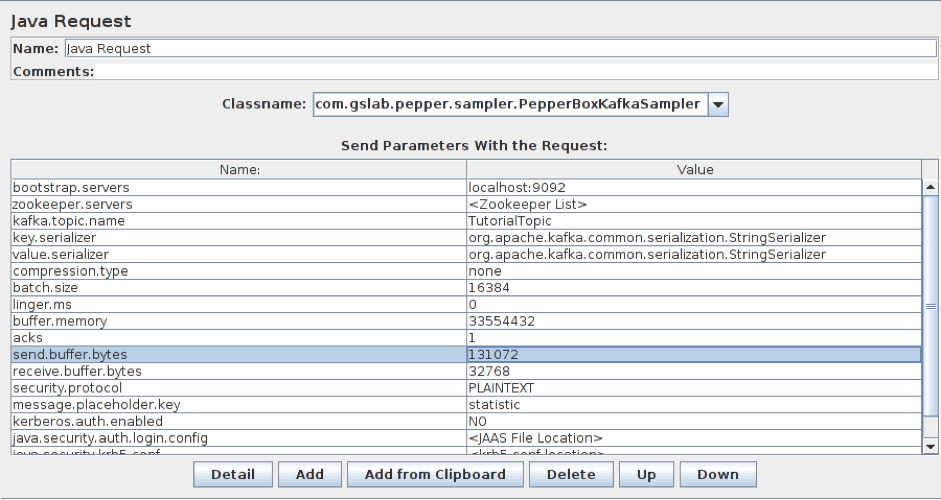
3. Add the JSR223 Sampler with the consumer code to a separate Thread Group. For it to work, you will also need a kafka-clients-x.x.x.x.jar files that contains classes for working with Kafka. You can find it in your kafka directory - /kafka/lib.
Here, we modified part of the script and now it saves the data to a file rather than displaying it in the console. This has been done for a more convenient analysis of the results. We also added the part that is necessary for setting the execution time of the consumer. For the demonstration it is setted at 5 seconds.
Updated part:
long t = System.currentTimeMillis();
long end = t + 5000;
f = new FileOutputStream(".\\data.csv", true);
p = new PrintStream(f);
while (System.currentTimeMillis()<end)
{
ConsumerRecords<String, String> records = consumer.poll(100);
for (ConsumerRecord<String, String> record : records)
{
p.println( "offset = " + record.offset() +" value = " + record.value());
}
consumer.commitSync();
}
consumer.close();
p.close();
f.close();
Now the structure of the script looks as follows. Both threads work simultaneously. The Producers begin to publish messages to the specified topics. The Consumers connect to the topics and wait for messages from Kafka. When a message is received by the Consumer, it writes the message to a file.

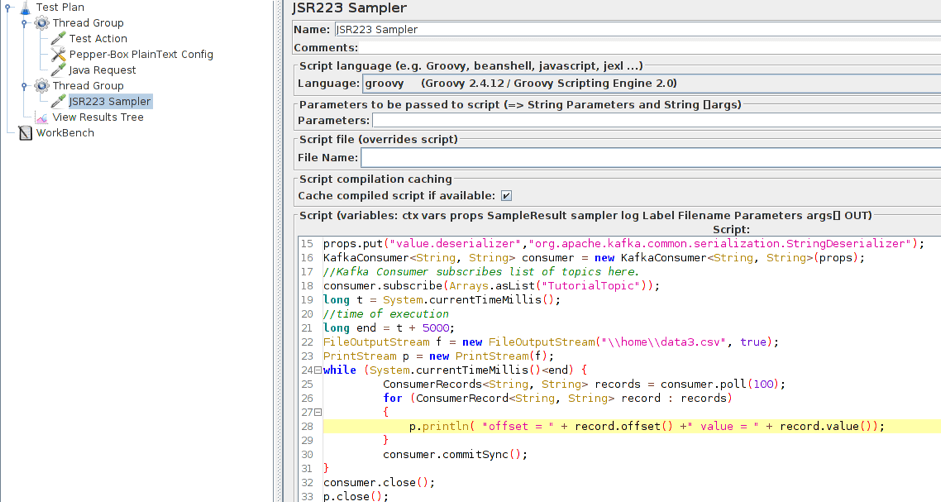
4. Run the script and view the results.

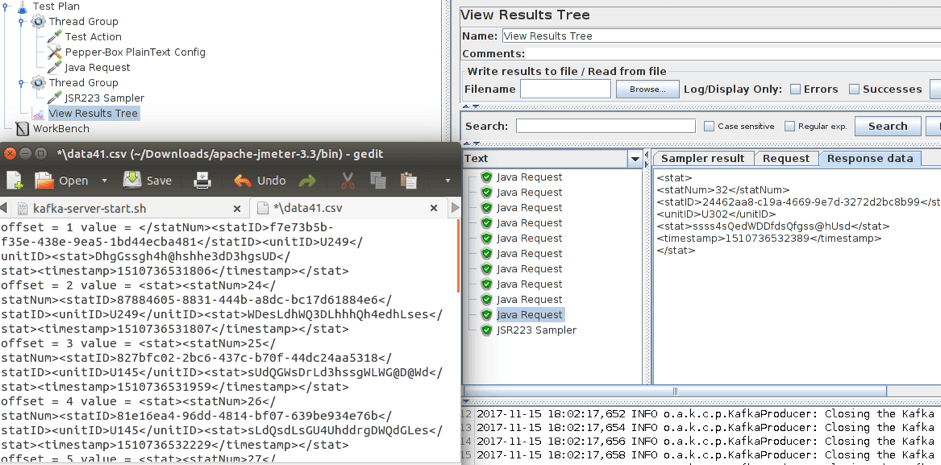
As you can see in the screenshot above, ten messages were sent. You can see the received messages in the opened file. After that, you just have to adjust the number of consumers and producers to increase the load.
Update:
If you get the following error when you try to run the scenario:


this means that JMeter uses JRE instead of JDK and you need to fix it, because JDK is a Pepper-box requirement.
Windows:
- Right click My Computer -> Properties -> Advanced -> Environment Variables
- Set path to JDK in Value field of JAVA_HOME Variable
- Run JMeter using jmeter.bat


Ubuntu:
- Write sudo update-alternatives --config java and choose the right option (in this case it is 3).
- Run JMeter using jmeter.sh


It is worth reminding that the Apache Kafka is designed for a large number of connections, so you can simply reach the capacity limit of your network load generator. In which case, JMeter maintains the feature of distributed testing.
I would also like to note that there is no point using random data for messages during the testing, since they can differ in size significantly from the current ones, and this difference may affect the test results. Please, take test data seriously.
Apache Kafka - How to Load Test with JMeter的更多相关文章
- 使用JMeter进行Apache Kafka负载测试
1.卡夫卡负载测试 在这个Apache Kafka教程中,我们将了解如何使用Apache JMeter,如何在Apache Kafka上执行Kafka负载测试.此外,这个Kafka负载测试教程教我们如 ...
- JMeter进行Apache Kafka负载测试
1.卡夫卡负载测试 在这个Apache Kafka教程中,我们将了解如何使用Apache JMeter,如何在Apache Kafka上执行Kafka负载测试.此外,这个Kafka负载测试教程教我们如 ...
- Apache Kafka: Next Generation Distributed Messaging System---reference
Introduction Apache Kafka is a distributed publish-subscribe messaging system. It was originally dev ...
- apache kafka系列之-监控指标
apache kafka中国社区QQ群:162272557 1.监控目标 1.当系统可能或处于亚健康状态时及时提醒,预防故障发生 2.报警提示 a.短信方式 b.邮件 2.监控内容 2.1 机器监控 ...
- Configuring Apache Kafka for Performance and Resource Management
Apache Kafka is optimized for small messages. According to benchmarks, the best performance occurs w ...
- Benchmarking Apache Kafka: 2 Million Writes Per Second (On Three Cheap Machines)
I wrote a blog post about how LinkedIn uses Apache Kafka as a central publish-subscribe log for inte ...
- How-to: Do Real-Time Log Analytics with Apache Kafka, Cloudera Search, and Hue
Cloudera recently announced formal support for Apache Kafka. This simple use case illustrates how to ...
- 《Apache kafka实战》读书笔记-kafka集群监控工具
<Apache kafka实战>读书笔记-kafka集群监控工具 作者:尹正杰 版权声明:原创作品,谢绝转载!否则将追究法律责任. 如官网所述,Kafka使用基于yammer metric ...
- 《Apache Kafka 实战》读书笔记-认识Apache Kafka
<Apache Kafka 实战>读书笔记-认识Apache Kafka 作者:尹正杰 版权声明:原创作品,谢绝转载!否则将追究法律责任. 一.kafka概要设计 kafka在设计初衷就是 ...
随机推荐
- 百度云BCC主机宝镜像
重装系统 在bcc服务器中,选实例,然后重装系统,镜像选择为主机宝CentOS6.5. 装完后,查看主机宝CentOS6.5官方文档. 登录主机宝管理界面 使用 root 用户登录 SSH 终端执行: ...
- Kubernetes CNI网络插件
CNI 容器网络接口,就是在网络解决方案由网络插件提供,这些插件配置容器网络则通过CNI定义的接口来完成,也就是CNI定义的是容器运行环境与网络插件之间的接口规范.这个接口只关心容器的网络连接,在创建 ...
- APS的未来会怎么样?历史给了你答案
一项技术从概念推广到实际应用推广需要十五到二十年时间,21世纪的头十年是APS的概念推广时期,随着理论的成熟,软件的实用化,企业应用的深入,下一个十年,APS将是实际应用推广的时期. APS兴起 从上 ...
- java 使用tess4j实现OCR的最简单样例
网上很多教程没有介绍清楚tessdata的位置,以及怎么配置,并且对中文库的描述也存在问题,这里介绍一个最简单的样例. 1.使用maven,直接引入依赖,确保你的工程JDK是1.8以上 <dep ...
- Spring之IoC详解(非原创)
文章大纲 一.Spring介绍二.Spring的IoC实战三.IoC常见注解总结四.项目源码及参考资料下载五.参考文章 一.Spring介绍 1. 什么是Spring Spring是分层的Java ...
- lower_case_table_names和数据库在Linux和windows平台之间的相互迁移问题
MySQL关于 lower_case_table_names 的文档 https://dev.mysql.com/doc/refman/5.7/en/identifier-case-sensitivi ...
- MySQL读写分离之MyCAT
Mycat实现MySQL主从复制读写分离 MyCAT的安装及部署 1.部署jdk环境 MyCAT用Java开发,需要有JAVA运行环境,mycat依赖jdk1.7的环境 1)上传jdk [root@l ...
- UE4 Keynote 1
[UE4 Keynote 1] 1.U3D中的Project,在UE4中叫 ContentBrowser,中文名叫“内容浏览器” 最多可以打开4个ContentBrowser,通过 “窗口” -> ...
- hbase运行原理
HBase特点 1)海量存储 Hbase适合存储PB级别的海量数据,在PB级别的数据以及采用廉价PC存储的情况下,能在几十到百毫秒内返回数据.这与Hbase的极易扩展性息息相关.正式因为Hbase良好 ...
- Python实战之ATM+购物车
ATM + 购物车 需求分析 ''' - 额度 15000或自定义 - 实现购物商城,买东西加入 购物车,调用信用卡接口结账 - 可以提现,手续费5% - 支持多账户登录 - 支持账户间转账 - 记录 ...
